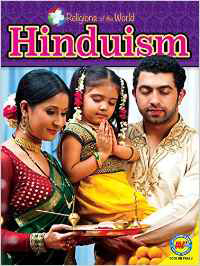| ________________
CM . . .
. Volume XXII Number 26. . . .March 11, 2016

 |
Buddhism. (Religions of the World).
Rita Faelli.
New York, NY: AV² by Weigl (Distributed in Canada by Saunders Book Company), 2016.
32 pp., pbk., hc. & eBook, $24.00 (hc.).
ISBN 978-1-4896-4024-6 (pbk.), ISBN 978-1-4896-3392-7 (hc.), ISBN 978-1-4896-3394-1 (single-user eBook), ISBN 978-1-4896-3395-8 (multi-user eBook).
Grades 3-5 / Ages 8-10.
Review by Gail Hamilton.
**½ /4
|
| |
|
 |
Christianity. (Religions of the World).
Rita Faelli.
New York, NY: AV² by Weigl (Distributed in Canada by Saunders Book Company), 2016.
32 pp., pbk., hc. & eBook, $24.00 (hc.).
ISBN 978-1-4896-4028-4 (pbk.), ISBN 978-1-4896-4027-7 (hc.), ISBN 978-1-4896-4029-1 (single-user eBook), ISBN 978-1-4896-4030-7 (multi-user eBook).
Grades 3-5 / Ages 8-10.
Review by Gail Hamilton.
**½ /4
|
| |
|
 |
Hinduism. (Religions of the World).
Rita Faelli.
New York, NY: AV² by Weigl (Distributed in Canada by Saunders Book Company), 2016.
32 pp., pbk., hc. & eBook, $24.00 (hc.).
ISBN 978-1-4896-4032-1 (pbk.), ISBN 978-1-4896-4031-4 (hc.), ISBN 978-1-4896-4033-8 (single-user eBook), ISBN 978-1-4896-4034-5 (multi-user eBook).
Grades 3-5 / Ages 8-10.
Review by Gail Hamilton.
**½ /4
|
| |
|
 |
Islam. (Religions of the World).
Rita Faelli.
New York, NY: AV² by Weigl (Distributed in Canada by Saunders Book Company), 2016.
32 pp., pbk., hc. & eBook, $24.00 (hc.).
ISBN 978-1-4896-4036-9 (pbk.), ISBN 978-1-4896-4035-2 (hc.), ISBN 978-1-4896-4037-6 (single-user eBook), ISBN 978-1-4896-4038-3 (multi-user eBook).
Grades 3-5 / Ages 8-10.
Review by Gail Hamilton.
**½ /4
|
| |
|
 |
Judaism. (Religions of the World).
Rita Faelli.
New York, NY: AV² by Weigl (Distributed in Canada by Saunders Book Company), 2016.
32 pp., pbk., hc. & eBook, $24.00 (hc.).
ISBN 978-1-4896-4040-6 (pbk.), ISBN 978-1-4896-4039-0 (hc.), ISBN 978-1-4896-4041-3 (single-user eBook), ISBN 978-1-4896-4040-0 (multi-user eBook).
Grades 3-5 / Ages 8-10.
Review by Gail Hamilton.
**½ /4
|
| |
|

excerpt:
For many years, Buddha’s teachings were passed on by word. His followers would recite, word for word, what Buddha had said in his teaching. These teachings are called sutras.
Hundreds of years later, these sutras were written down. They always begin with the words, “Thus have I heard.”
Buddhist holy books have been translated into many different languages. The collection of Buddhist writings is called the Tripitaka. It includes the sutras, rules and practices for behavior, and writings that explain the sutras. (From Buddhism.)
These titles comprise the “Religions of the World” series as well as being part of the AV² collection of books. AV refers to “added value audio visual”. In order to access the AV² aspect of the books, readers must log in to the AV² web page and enter the book’s unique code which is found on the second page. A further security step is involved in which readers must answer a question about the book in order to continue. Once the final step is complete, readers will find 10 different activities (one for each double-page spread) to try. These include videos, fill-in-the-blank pages, matching photos with their descriptors, true/false quizzes, web links and writing activities. Some of the videos and web links are not age appropriate due to their higher vocabulary as well as their lack of usefulness. For instance, a few of the links lead to web pages for a specific place of worship. It is doubtful that young readers will want to peruse the newsletters and announcements that are posted there.
The books contain information about the origin of the featured religion, places and forms of worship, beliefs and practices, spiritual leaders, important dates of holidays, celebrations or festivals, traditions associated with major life events, such as birth, marriages and death, and the symbols associated with the religion. “Fast Facts” sections provide interesting trivia. The text, printed in a large, simple font, is easy for readers to comprehend and is enhanced by colour photographs. A table of contents, a glossary and an index are included.
Begun in India by Siddhartha Gautama, a prince who renounced his wealth and worldly possessions, Buddhism has about 350 million followers today. In Buddhism, readers will learn about the meaning of the word “Buddha”, the different schools of Buddhism and the basic beliefs that they share, in particular the Three Gems- Buddha, the teacher; Dharma, the teachings or laws of Buddhism; and Sangha, the community of monks and nuns. The importance of karma, meditation and enlightenment, are discussed along with symbols associated with the religion- the Buddhist flag, mandalas and the lotus, as well as the symbolic poses of the images and statues of Buddha. For instance, if his hand is resting in his lap, it is a reminder to become calm and peaceful, whereas, if his right hand is touching the ground, this represents determination. The first video of the AV² activities shows the spread of Buddhism throughout the world. Unfortunately, the images that come up are too small to see clearly or to read the labelling at the bottom. A web link to the Bodhi Monastery site will not likely appeal to readers. However, the last two web links are very useful, the first of which provides a great deal of information not found in the book (e.g. the Three Signs of Being, the Four Noble Truths, and the Noble Eightfold Path), and the last one which explains the basic beliefs in a very user-friendly manner.
Christianity, the world’s largest religion, began over 2,000 years ago and is based on the teachings of Jesus Christ. Like Buddhism, Christianity has many different groups, but their basic beliefs are the same. In Christianity, there is information about the Trinity, the Bible, Jesus’s disciples and the Resurrection, important dates on the Christian calendar, such as Christmas, Lent and Easter, the cross symbol, and customs surrounding baptism, confirmation and marriage. One of the videos takes readers on a tour of the exterior and interior of a church. Unfortunately, the first video of the AV² activities is too fast and too confusing (a cartoonist attempts to explain the Trinity to viewers), and the last web link is too detailed and too high in vocabulary for the target audience.
Hinduism, the Sanatana Dharma or Eternal Way, has 900 million followers. This religion, based on ancient religious traditions of India, does not have a founder. Its followers believe in many gods and goddesses, rebirth and karma, and living a life of worship, hard work, non-violence, and respect for others. Hinduism highlights other aspects of the religion as well: the importance of meditation and yoga, the sacred books called the Vedas, parts of a temple, and Diwali, the Festival of Lights. The first video contains a few facts that contradict the information in the book and the narrator speaks too quickly, Other activities, such as the fast fact sheets web link and the video of the Hindu temple, are helpful.
Islam’s followers are called Muslims, and their holy book is the Qur’an. Muslims believe in one God, Allah, and in prophets, messengers that were sent to Earth by Allah to teach them how to live. In Islam, readers will learn about the Five Pillars of Islam, a mosque, the role of the imam, rules about food and clothing, and Ramadan. One interesting fact is that there are no statues or paintings of people in a mosque. The first video is done in cartoon style (although the figures are flat and stiff) and explains the Five Pillars. In the video, two young boys, one of them a Muslim, go to a mosque. The Muslim child shows his friend the traditions he follows each time he prays. Another video, though lovely to watch, is not very useful. It shows a woman writing in Arabic. One of the web links is a newsletter from a mosque, also not very useful from a child’s point of view.
Judaism began in the Middle East over 4,000 years ago. The Torah is its holy book, and the Talmud is a collection of writings containing Jewish laws and teachings. Information found in Judaism includes facts about holidays such as Passover, Yom Kippur and Hanukkah, the kippah (yarmulke) and tallit (prayer shawl), kosher food, the synagogue, and symbols such as the Star of David. The religion’s most important prayer is called the Shema, a copy of which is printed on parchment and placed in a mezuzah which is affixed to the door post of a Jewish person’s home. Once again, the videos and web links are not particularly useful. The first video very briefly explains the three main denominations of Judaism (Orthodox, Conservative and reform), but there is not much in the way of information, and the second shows how to fold an origami Star of David. One of the web links shows three black and white archival photos, two of them of the first synagogues in the U.S. in Newport, and the third of a fancy estate house. Perhaps it would have been better to find photos of the oldest synagogues in the world, or a video or web link about the Wailing Wall or how Jewish families celebrate a particular holiday.
Generally speaking, the series books are perfect for the target age group, but the accompanying AV² activities, especially the web-based ones, are hit and miss.
Recommended with Reservations.
Gail Hamilton is a former teacher-librarian in Winnipeg, MB.

To comment
on this title or this review, send mail to cm@umanitoba.ca.
Copyright © the Manitoba Library Association. Reproduction for personal
use is permitted only if this copyright notice is maintained. Any
other reproduction is prohibited without permission.
Next Review | Table of Contents For This Issue - March 26, 2016
CM Home | Back Issues
| Search
| CM Archive
| Profiles Archive
|




